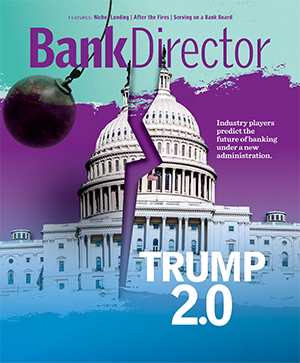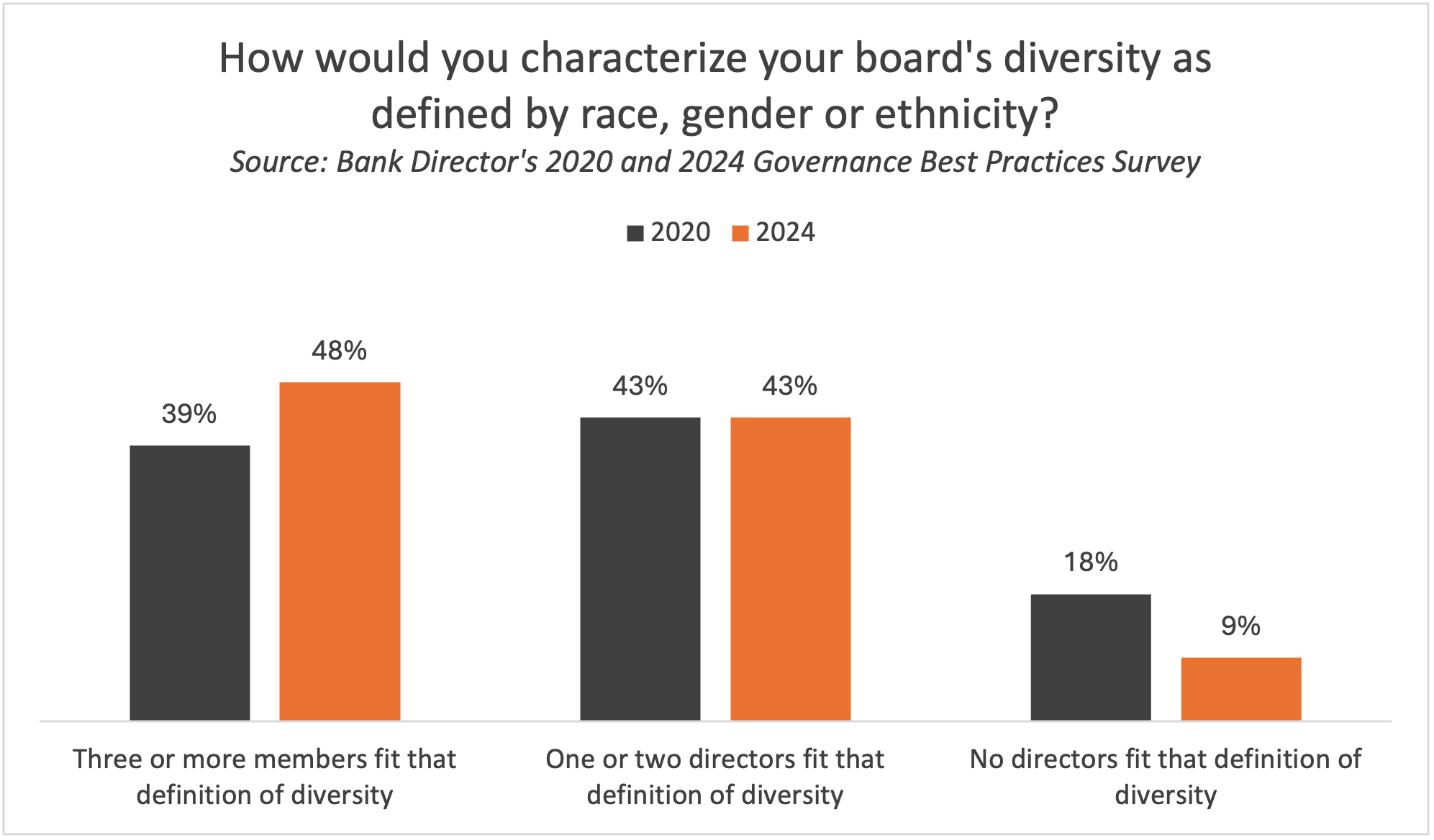Emily McCormick is Vice President of Editorial & Research for Bank Director. Emily oversees research projects, from in-depth reports to Bank Director’s annual surveys on M&A, risk, compensation, governance and technology. She also manages content for the Bank Services Program, including Bank Director’s Online Training Series. In addition to speaking and moderating discussions at Bank Director’s in-person and virtual events, Emily writes and edits for Bank Director magazine, BankDirector.com and Bank Director’s weekly newsletter, The Slant. She started her career in the circulation department at the Knoxville News-Sentinel and graduated summa cum laude from The University of Tennessee with a bachelor’s degree in Spanish and International Business.

What’s Driving Diversity in the Boardroom
Boards have shifted their compositions to better reflect different backgrounds — particularly by adding women. Here’s why.
*This article is part of a larger series on “The Shifting DEI Landscape.”
In 1992, the cover of Bank Director magazine featured a large wooden door, barely ajar. A woman, dressed in a red suit, struggled to push it open.
“Boardroom,” the door was labeled. “For Men Only.”
At the time, women served as directors at 70% of roughly 14,000 U.S. banks, but fewer than 10% had more than one woman on the board, according to the article.
Boards look different today. The job’s arguably grown tougher as the industry has grappled with more regulation, more risks and an increasingly digital competitive landscape. As bank boards have increasingly professionalized in response, that has required more skills and backgrounds in the boardroom, including women and professionals from underrepresented racial and ethnic backgrounds.
Investors care about who’s in the boardroom, says Jennifer Docherty, cofounder and chair at the nonprofit Bank on Women. “They want to know what the expertise on the board is,” she explains. “They want to know that the board is not comprised of people who come from the same backgrounds [and] who all think the same way.”
Just five years ago, 39% of the directors and CEOs responding to Bank Director’s 2020 Governance Best Practices Survey said three or more of their bank’s directors represented diverse backgrounds, based on race, ethnicity or gender; 18% had no members with those attributes. By 2024, almost half (48%) had three or more directors with diverse backgrounds, while the percentage representing non-diverse boards dropped to 9%.
But the boards of small, private banks, which are less likely to feel pressured by investors, have diversified, too. In 2020, 31% of directors from private banks said their institution lacked diversity in the boardroom, based on race, ethnicity or gender. That percentage dropped to 17% in Bank Director’s 2024 Governance Best Practices Survey.
Boards increasingly see the benefits of having talented directors because it makes their organizations better, says Docherty. “Banks are all about driving performance. They make strategic decisions based on what makes sense for their institution.”
Bank Director’s 2024 Governance Best Practices Survey found a link between diversity and a critical board responsibility: providing a credible challenge to management. The Federal Deposit Insurance Corp. has described the practice as “engaging in robust discussions with senior management and perhaps challenging recommendations at times, rather than simply deferring to their decisions.” The survey found that respondents from boards with at least three diverse directors, defined by race, gender or ethnicity, were significantly less likely to cite a lack of credible challenge as a cultural deficiency, compared to boards that lacked those types of diversity altogether.
The representation of women has seen great gains in boardrooms over the years, with some boards achieving what academic circles call “critical mass.” A 2006 paper, titled “Critical Mass on Corporate Boards: Why Three or More Women Enhance Governance,” by Vicki Kramer, Alison Konrad and Sumru Erkut, explained the concept. A lone woman may be excluded from discussions; having a second woman on the board can alleviate that. But “increasing the number of women to three or more enhances the likelihood that women’s voices and ideas are heard and that boardroom dynamics change substantially,” the research found.
Bank on Women has examined the composition of Nasdaq-traded bank boards and found a growing percentage with three or more women. This figure jumped from 31% in June 2021 to 54% in December 2024. The organization found that having more women in the boardroom led to stronger financial results. Nasdaq-traded banks with critical mass — which Bank on Women defines as 30% of board members — reported higher profitability, based on return on average assets, outperforming less-diverse boards.
Could the next few years see fewer women in bank boardrooms? The political climate has become unfavorable for diversity initiatives, and that has the potential to affect board recruitment and composition. Additionally, recent regulations emphasizing diversity in the boardroom have been rescinded or overturned, including proposed corporate governance guidelines from the FDIC and a Nasdaq rule that mandated a certain level of diversity.
Large asset managers have deemphasized diversity expectations in proxy voting guidelines. Institutional Shareholder Services, the proxy advisor, announced on Feb. 11 that it would “indefinitely halt consideration of certain diversity factors in making vote recommendations with respect to directors at U.S. companies.”
On March 4, Glass Lewis & Co. announced it would instead “flag” diversity-based recommendations on director elections as a way to better inform investors.
“We continue to believe that diversity contributes to improved company performance and long-term shareholder value,” the proxy advisory firm said. “… a board can best protect and enhance the interests of shareholders if it is sufficiently independent, has a record of positive performance, and consists of individuals with diverse backgrounds and relevant experience.”






